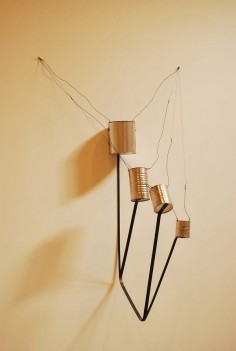Al Taylor
source: davidzwirner
Al Taylor (1948-1999) was an American artist known for his uniquely innovative approach to process and materials that encompassed two-dimensional drawings and three-dimensional objects. Taylor ultimately sought to expand the possibilities of vision by creating new ways of experiencing and imagining space and his work provides the viewer with an insight into the artist’s thinking and his investigations of perception across several dimensions.
Taylor was born in Springfield, Missouri and received a B.F.A. from the Kansas City Art Institute in 1970. He moved to New York later that year, where he would continue to live and work until his death in 1999. His first solo exhibition took place in 1986 at the Alfred Kren Gallery in New York. His work would go on to be shown in numerous exhibitions in America and Europe, including solo exhibitions at the Kunsthalle Bern (1992) and the Kunstmuseum Luzern (1999), both in Switzerland. A retrospective of Taylor’s drawings was organized posthumously by the Staatliche Graphische Sammlung at the Pinakothek der Moderne, Munich in 2006. His work is found in a number of prominent public collections, including The Museum of Modern Art, New York; the National Gallery of Art, Washington, D.C.; the Museum of Fine Arts, Houston; the Whitney Museum of American Art, New York; Glenstone, Potomac, Maryland; and the Musée National d’Art Moderne, Centre Georges Pompidou, Paris. A retrospective of the artist’s prints opened at the Pinakothek der Moderne, Munich in September 2010, and travelled to the Louisiana Museum of Modern Art, Humlebaek, Denmark in Spring 2011. The Santa Monica Museum of Art, California, presented a focused overview of two bodies of work by the artist, Wire Instruments and Pet Stain Removal Devices, in 2011. In 2013, the High Museum of Art in Atlanta mounted the exhibition Drawing Instruments: Al Taylor’s Bat Parts and End Cuts. In 2014, The Philip Johnson Glass House in New Canaan, Connecticut, presented Six Panels: Al Taylor, curated by Robert Storr. A retrospective of the artist’s work, organized by the High Museum of Art, will open in Atlanta in 2016.
The Estate of Al Taylor has been represented by David Zwirner since 2007. Since then, Taylor has had four solo exhibitions with the gallery: Al Taylor: Early Work (2008), Al Taylor: Rim Jobs and Sideffects (2010), Al Taylor: Pass the Peas and Can Studys (2012), and Al Taylor (2014) at our Mayfair, London space. The artist’s fifth solo exhibition, Pet Stains, Puddles, and Full Gospel Neckless, will be on view at our 537 West 20th Street location from January 9 – February 14, 2015.
.
.
.
.
.
.
.
source: artsynet
Al Taylor, who began as a painter and also worked as a set design assistant and studio assistant to Robert Rauschenberg, made drawings and sculptures that blurred the boundaries between two- and three-dimensional space. A 1980 trip to Africa, where he saw children fashioning toys from trash, inspired him to make constructions out of materials like broomsticks, wood slats, wire, and Styrofoam. Pet Stain Removal Device #1 (1988–89) is typical of Taylor’s humor—a piece of plywood painted with a black “stain” is suspended from a wood and aluminum contraption. Taylor is also known for bringing charm and humor to the austerity of Process Art.
.
.
.
.
.
.
.
source: unstverein-bremerhavende
Al Taylor, geboren 1948 in Springfield, Missouri. Der Künstler studierte am Kansas City Art Institute. 1970 zog er nach New York, wo er bis zu seinem Tod 1999 lebte und arbeitete. Seine Werke befinden sich unter anderem in namhaften Sammlungen wie dem Museum of Modern Art, New York, dem Centre national d`art et culture Georges Pompidou, Paris, und der Staatlichen Graphischen Sammlung, München.
Die fragilen Gebilde Al Taylors aus Alltagsmaterialien, wie Draht, Weißblechdosen und Holz gezeigt. An die Wand gelehnt oder mit Draht verspannt entwickeln die Werke ein Wechselspiel aus Linie und Volumen, Sichtbarkeit und Unsichtbarkeit, Licht und Schatten. Die raumgreifenden Drahtverspannungen der Installationen sowie die derben Materialien stehen im Kontrast zur Leichtigkeit der Erscheinung. Seine Objekte besitzen keine geometrische Präzision, sondern die Lockerheit der Handzeichnung.
Mitte der 1980er Jahre begann AL Taylor mit Zeichnungen und Objekten, für die er sich aus Beobachtungen, von allem was ihn umgab, inspirieren ließ. Bei der Entstehung seiner Installationen legte der Künstler besonderen Wert auf die Schattenlinien, die die Werke auf die Wand werfen und die für ihn konstituierender Bestandteil der Arbeit waren. Hierin zeigt sich besonders eindrücklich, dass sich Al Taylor in erster Linie als Maler und Zeichner verstand, nicht als Bildhauer. Nicht Masse und Volumen, klassischer Inhalt der Bildhauerei, sondern Linie und Raum, eher zeichnerisch belegte Fragestellungen, werden in den Werken thematisiert. In seinen Werken erforschte Al Taylor die Möglichkeiten des Visuellen, indem er sowohl zweidimensional in Zeichnungen arbeitete, als auch seine Ideen in die dritte Dimension umsetzte. Die Papierarbeiten Taylors sind jedoch keinesfalls nur Skizzen oder Vorstudien, sondern stellen eigenständige Werke dar, die im Wechsel mit Installationen entstanden. „Für mich ist es wirklich das gleiche, auf Papier oder an dreidimensionalen Stücken zu arbeiten; es ist alles eine Tätigkeit, und ich habe kein Interesse daran, es zu trennen“ erklärte Al Taylor 1992. Entsprechend verstand er seine Objekte als „Zeichnungen im Raum“.


